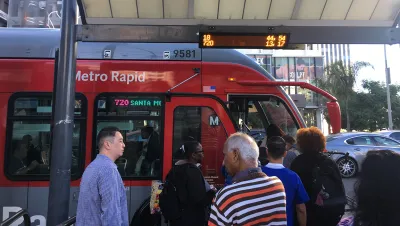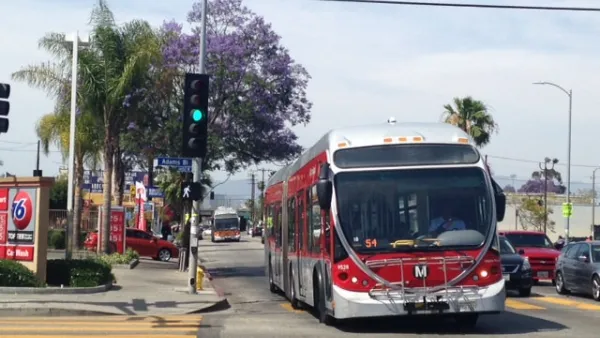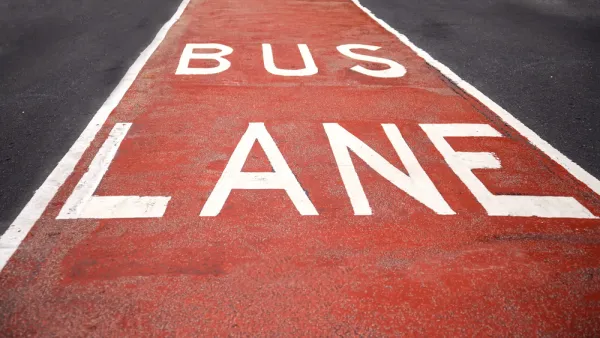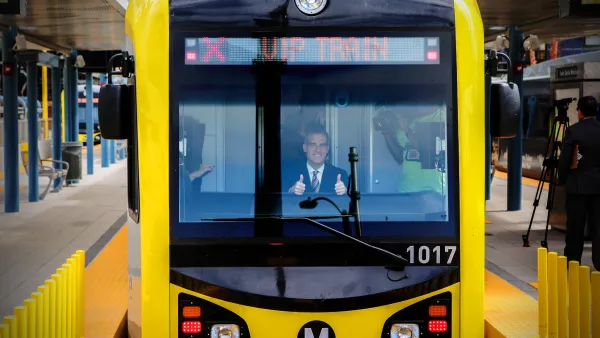Flagging ridership on Metro buses in Los Angeles redoubles the need to speed buses up with dedicated lanes, hopefully recovering lost riders and finding some news ones along the way, too.

Juan Matute, deputy director of the UCLA Institute of Transportation Studies, writes an opinion piece for the Los Angeles Times that digs into the spiraling consequences of declining ridership and bus speeds on the transit systems of Los Angeles and environs.
Average bus speeds in the Los Angeles metropolitan area have declined by 13.4% since 1994 to a sluggish 12 mph. The Los Angeles Department of Transportation’s DASH buses and Santa Monica’s Big Blue bus have been especially hard hit by congestion over that time period, with speeds declining 34% and 28%, respectively.
Ridership, not surprisingly, has plummeted along with speeds. The ripple effect of both is enormous: More traffic, of course, as people jettison Metro passes for cars; even slower traffic because of more congestion; taxpayer money wasted as transit drivers sit in all that traffic. Most concerning, however, is that slow buses with low occupancy rates are inefficient greenhouse gas emitters that could prevent Los Angeles from doing its part to fight climate change.
Matute places the magic number for ridership on a bus at eight. An average passenger total lower than that makes the bus less efficient than a driver alone in a car. If the transit agency is running buses that used renewable natural gas (captured from landfills and dairy farms) that number drops to four. L.A.-are buses are steadily approaching that threshold, according to Matute:
The occupancy of Los Angeles-area buses — roughly 4,000 run in L.A. and Orange counties each weekday — has declined from 14.8 passengers in 1994 to 12 passengers in 2017 (the latest complete data). And all signs show it’s still dropping. One of our greatest assets in the fight against climate change is turning into a liability.
Matute doesn't just sound the alarm, however. Also included in this opinion piece is a prescription for reversing all of that decline: bus-only lanes, like the Wilshire Boulevard lane that still frequently suffers from scofflaw automobile drivers and lack of enforcement. Matutue doesn't just recommend bus-only lanes, but also ways to better ensure that bus-only lanes speed buses up and attract new riders, like they've done in the San Francisco.
FULL STORY: L.A.’s slow buses aren’t just shedding riders, they’re becoming climate liabilities

National Parks Layoffs Will Cause Communities to Lose Billions
Thousands of essential park workers were laid off this week, just before the busy spring break season.

Retro-silient?: America’s First “Eco-burb,” The Woodlands Turns 50
A master-planned community north of Houston offers lessons on green infrastructure and resilient design, but falls short of its founder’s lofty affordability and walkability goals.

Delivering for America Plan Will Downgrade Mail Service in at Least 49.5 Percent of Zip Codes
Republican and Democrat lawmakers criticize the plan for its disproportionate negative impact on rural communities.

Test News Post 1
This is a summary

Test News Headline 46
Test for the image on the front page.

Balancing Bombs and Butterflies: How the National Guard Protects a Rare Species
The National Guard at Fort Indiantown Gap uses GIS technology and land management strategies to balance military training with conservation efforts, ensuring the survival of the rare eastern regal fritillary butterfly.
Urban Design for Planners 1: Software Tools
This six-course series explores essential urban design concepts using open source software and equips planners with the tools they need to participate fully in the urban design process.
Planning for Universal Design
Learn the tools for implementing Universal Design in planning regulations.
EMC Planning Group, Inc.
Planetizen
Planetizen
Mpact (formerly Rail~Volution)
Great Falls Development Authority, Inc.
HUDs Office of Policy Development and Research
NYU Wagner Graduate School of Public Service





























